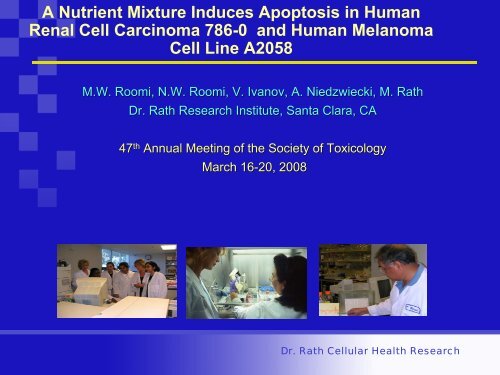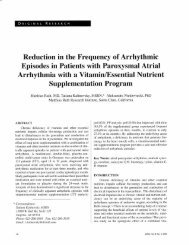SOT_2008_apoptosis.pdf - Dr. Rath Research Institute
SOT_2008_apoptosis.pdf - Dr. Rath Research Institute
SOT_2008_apoptosis.pdf - Dr. Rath Research Institute
Create successful ePaper yourself
Turn your PDF publications into a flip-book with our unique Google optimized e-Paper software.
A Nutrient Mixture Induces Apoptosis in Human<br />
Renal Cell Carcinoma 786-0 and Human Melanoma<br />
Cell Line A2058<br />
M.W. Roomi, N.W. Roomi, , V. Ivanov, A. Niedzwiecki, M. <strong>Rath</strong><br />
<strong>Dr</strong>. <strong>Rath</strong> <strong>Research</strong> <strong>Institute</strong>, Santa Clara, CA<br />
47 th Annual Meeting of the Society of Toxicology<br />
March 16-20, <strong>2008</strong><br />
<strong>Dr</strong>. <strong>Rath</strong> Cellular Health <strong>Research</strong>
Introduction<br />
Renal cell carcinoma (RCC) is erratic and unpredictable even<br />
when diagnosed. Incidence of RCC is higher among African<br />
Americans than among Caucasians. The male to female ratio for<br />
RCC is 2:1. At diagnosis, five-year survival is limited to 60% in<br />
RCC patients.<br />
Melanoma, a very serious form of skin cancer, is a relatively rare<br />
cancer. However, its incidence rate in the U.S. has been<br />
increasing steadily, and in 2003, it was the sixth most common<br />
cancer in the U.S. Though often curable in its early stages,<br />
melanoma may metastasize to other areas of the body.<br />
<strong>Dr</strong>. <strong>Rath</strong> Cellular Health <strong>Research</strong>
Introduction<br />
A novel nutrient mixture (NM) containing lysine,<br />
proline, ascorbic acid and green tea extract has<br />
shown a wide range of pharmacological properties,<br />
including a broad spectrum of antitumor activity<br />
against a number of human cancer cell lines.<br />
We investigated whether the underlying antitumor<br />
effect of NM was due to <strong>apoptosis</strong> in human RCC<br />
and melanoma, studying its effect on caspases,<br />
proliferation and morphology. In addition, we<br />
investigated its effect on MMP-2 and MMP-9<br />
secretion and Matrigel invasion of these cells.<br />
<strong>Dr</strong>. <strong>Rath</strong> Cellular Health <strong>Research</strong>
Composition of Nutrient Mixture (NM)<br />
Nutrient<br />
Vitamin C<br />
L-Lysine<br />
L-Proline<br />
L-Arginine<br />
N-Acetyl Cysteine<br />
Green Tea Extract<br />
Selenium<br />
Copper<br />
Manganese<br />
Molar Concentration<br />
(in 100 μg/ml solution)<br />
90 μM<br />
110 μM<br />
110 μM<br />
50 μM<br />
25 μM<br />
EGCG 15 μM<br />
8.5 μM<br />
700 nM<br />
400 nM<br />
<strong>Dr</strong>. <strong>Rath</strong> Cellular Health <strong>Research</strong>
Methods<br />
Human RCC 786-0 and human melanoma cells A2058<br />
(ATCC) were cultured in RPMI and DMEM media<br />
respectively, supplemented with 10% FBS and<br />
antibiotics. The cells were then challenged with NM at 0,<br />
50, 100, 500 and 1000 µg/ml concentration in triplicate at<br />
each concentration.<br />
• Cell toxicity was evaluated by MTT assay.<br />
• Apoptosis was determined by Live Green Caspase<br />
Detection Kit<br />
• Morphology was assessed by H&E staining<br />
• MMP-2 and MMP-9 secretion by gelatinase zymography<br />
• Invasion through Matrigel<br />
<strong>Dr</strong>. <strong>Rath</strong> Cellular Health <strong>Research</strong>
Effect of NM on RCC 786-0 Toxicity<br />
MTT Assay – 24h<br />
NM showed slight insignificant toxicity to RCC 786-0 cells at 100<br />
μg/ml NM, 10% at 500 μg/ml and 22% at 1000 μg/ml.<br />
Cell Proliferation, % of Control<br />
120<br />
100<br />
80<br />
60<br />
40<br />
20<br />
* = P= 0.003<br />
*<br />
0<br />
Control NM 100<br />
μg/ml<br />
NM 500<br />
μg/ml<br />
NM 1000<br />
μg/ml<br />
<strong>Dr</strong>. <strong>Rath</strong> Cellular Health <strong>Research</strong>
Effect of NM on RCC 786-0 Morphology<br />
H&E stain<br />
Though NM was not<br />
toxic to RCC 786-0<br />
cells, cells exposed to<br />
NM at 500 and 1000<br />
μg/ml showed obvious<br />
<strong>apoptosis</strong> by H&E<br />
stain. Apoptotic cells<br />
showed shrinkage with<br />
darkly stained and<br />
condensed nuclei and<br />
strong acidophilic<br />
cytoplasm.<br />
Control NM 100 µg/ml<br />
NM 500 µg/ml<br />
NM 1000 µg/ml<br />
<strong>Dr</strong>. <strong>Rath</strong> Cellular Health <strong>Research</strong>
Effect of NM on RCC 786-0 Apoptosis:<br />
Live green caspase detection kit<br />
Using the Live<br />
Green Caspases<br />
Detection Kit, a<br />
significant number<br />
of early and late<br />
apoptotic cells were<br />
evident when RCC<br />
786-0 cells were<br />
exposed to 500 and<br />
1000 μg/ml NM.<br />
Control NM 100 µg/ml<br />
NM 500 µg/ml<br />
NM 1000 µg/ml<br />
<strong>Dr</strong>. <strong>Rath</strong> Cellular Health <strong>Research</strong>
Effect of NM on RCC 786-0 Apoptosis<br />
% of Cells in Group<br />
120<br />
100<br />
80<br />
60<br />
40<br />
20<br />
0<br />
Live<br />
Early Apoptosis<br />
Late Apoptosis<br />
Control NM 100 μg/ml NM 500 μg/ml NM 1000<br />
μg/ml<br />
<strong>Dr</strong>. <strong>Rath</strong> Cellular Health <strong>Research</strong>
Effect of NM on RCC 786-0 MMP Secretion<br />
Gelatinase Zymography<br />
Zymography demonstrated secretion of MMP-2 by uninduced human<br />
RCC and both MMP-2 and-9 by PMA (200 ng/ml)-treated cells. NM<br />
inhibited secretion of both MMPs in a dose-dependent fashion with<br />
virtual total inhibition of MMP-2 at 500 μg/ml concentration and MMP-9<br />
at 100 μg/ml<br />
Untreated RCC 786-0 cells PMA (200 ng/ml-treated) RCC 786-0 cells<br />
MMP-9<br />
MMP-2<br />
1 2 3 4 5 6 7 1 2 3 4 5 6 7<br />
Legend: 1 - Markers, 2- Control, 3-7 NM 10, 50, 100, 500, 1000 μg/ml<br />
<strong>Dr</strong>. <strong>Rath</strong> Cellular Health <strong>Research</strong>
Effect of NM on RCC 786-0 Invasion<br />
through Matrigel<br />
The invasion of human RCC 786-0 cells through Matrigel was<br />
significantly inhibited in a dose-dependent manner, reducing invasion<br />
by 82% at 500 μg/ml and 100% at 1000 μg/ml NM.<br />
% Inhibition<br />
120<br />
100<br />
80<br />
60<br />
40<br />
20<br />
* = P = 0.005<br />
*<br />
*<br />
*<br />
*<br />
0<br />
Control NM 50<br />
μg/ml<br />
NM 100<br />
μg/ml<br />
NM 500<br />
μg/ml<br />
NM1000<br />
μg/ml<br />
<strong>Dr</strong>. <strong>Rath</strong> Cellular Health <strong>Research</strong>
Effect of NM on Melanoma A2058 Toxicity<br />
MTT Assay – 24h<br />
NM showed slight toxicity to melanoma A2058 cells at 100 μg/ml<br />
NM, and 64% and 66% at 500 and 1000 μg/ml, respectively<br />
Cell Proliferation, % of Control<br />
120<br />
100<br />
80<br />
60<br />
40<br />
20<br />
0<br />
* = P< 0.0001<br />
* *<br />
Control NM 100 μg/ml NM 500 μg/ml NM 1000<br />
μg/ml<br />
<strong>Dr</strong>. <strong>Rath</strong> Cellular Health <strong>Research</strong>
Effect of NM on Melanoma A2058 Morphology<br />
H&E staining<br />
Melanoma A2058<br />
cells treated with 100,<br />
500 and 1000 µg/ml<br />
NM showed obvious<br />
apoptotic cells by H&E<br />
staining. Apoptotic<br />
cells showed<br />
shrinkage with dark<br />
stained and<br />
condensed nuclei and<br />
strong acidophilic<br />
cytoplasm.<br />
Control NM 100 µg/ml<br />
NM 500 µg/ml<br />
NM 1000 µg/ml<br />
<strong>Dr</strong>. <strong>Rath</strong> Cellular Health <strong>Research</strong>
Effect of NM on Melanoma A2058 Apoptosis:<br />
Live green caspase detection kit<br />
Melanoma A2058 cells<br />
exposed to various<br />
concentrations of NM<br />
demonstrated a<br />
considerable number of<br />
early and late apoptotic<br />
cells at 100 μg/ml NM<br />
and a significantly<br />
increased number of<br />
apoptotic cells at 500 and<br />
1000 μg/ml NM.<br />
Control NM 100 µg/ml<br />
NM 500 µg/ml<br />
NM 1000 µg/ml<br />
<strong>Dr</strong>. <strong>Rath</strong> Cellular Health <strong>Research</strong>
Effect of NM on Melanoma A2058<br />
Apoptosis<br />
% of Cells in Group<br />
120<br />
100<br />
80<br />
60<br />
40<br />
20<br />
Live<br />
Early Apoptosis<br />
Late Apoptosis<br />
0<br />
Control NM 100 μg/ml NM 500 μg/ml NM 1000 μg/ml<br />
<strong>Dr</strong>. <strong>Rath</strong> Cellular Health <strong>Research</strong>
Effect of NM on Melanoma MMP Secretion<br />
Gelatinase Zymography<br />
Zymography detected MMP-2 secretion by human melanoma A2058<br />
cells and induced MMP-9 secretion with PMA (200ng/ml) treatment. NM<br />
inhibited both MMP-2 and MMP-9 activity in a dose-dependent fashion<br />
with virtual complete blockage of MMP-9 at 100 μg/ml and MMP-2 at<br />
500 μg/ml.<br />
Untreated melanoma A2058 cells PMA (200 ng/ml-treated) A2058 cells<br />
MMP-9<br />
MMP-2<br />
1 2 3 4 5 6 7 1 2 3 4 5 6 7<br />
Legend: 1 - Markers, 2- Control, 3-7 NM 10, 50, 100, 500, 1000 μg/ml<br />
<strong>Dr</strong>. <strong>Rath</strong> Cellular Health <strong>Research</strong>
Effect of NM on Melanoma Cell Invasion<br />
Through Matrigel<br />
Invasion of melanoma A2058 cells through Matrigel was inhibited by<br />
30%, 44% , 95% and 100% by 10, 50,100, and 500 μg/ml of NM,<br />
respectively.<br />
120<br />
Inhibition of Invasion, %<br />
100<br />
80<br />
60<br />
40<br />
20<br />
* = P = 0.005<br />
*<br />
*<br />
*<br />
*<br />
0<br />
Control NM 10<br />
μg/ml<br />
NM 50<br />
μg/ml<br />
NM 100<br />
μg/ml<br />
NM 500<br />
μg/ml<br />
<strong>Dr</strong>. <strong>Rath</strong> Cellular Health <strong>Research</strong>
Conclusions<br />
Our results suggest that the nutrient mixture plays an<br />
important role in suppressing RCC and melanoma<br />
cell proliferation, inducing <strong>apoptosis</strong>, inhibiting MMP-<br />
2 and MMP-9 secretion, and inhibiting invasion<br />
through Matrigel, suggesting its therapeutic potential<br />
as an anticancer agent in managing patients with<br />
RCC and melanoma.<br />
For further information on research activities,<br />
publications, and testimonials, visit our research<br />
website at:<br />
http:// www.drrathresearch.org<br />
<strong>Dr</strong>. <strong>Rath</strong> Cellular Health <strong>Research</strong>




